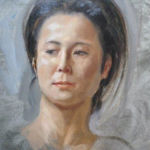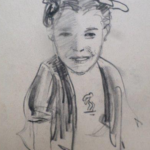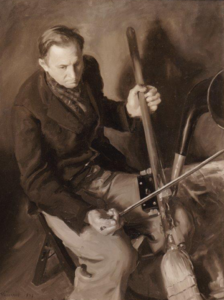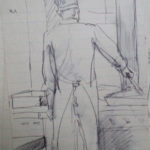“Mad Artist”: the Painting Life of Albert Wasserman
By Tessa Smith
 Albert Wasserman grew up on Nelson Avenue in the Highbridge section of the Bronx. In his early teens, Wasserman showed natural talent and serious interest in painting. He continued to expand his ability with practice, which included churning out many sketches and paintings of New York City’s oldest standing bridge – The High Bridge. In his senior year at Evander Childs High School in the Northeast Bronx, he was art editor and designer of his graduation yearbook in 1937 פתח. From then on, art remained a prominent theme in Wasserman’s life.
Albert Wasserman grew up on Nelson Avenue in the Highbridge section of the Bronx. In his early teens, Wasserman showed natural talent and serious interest in painting. He continued to expand his ability with practice, which included churning out many sketches and paintings of New York City’s oldest standing bridge – The High Bridge. In his senior year at Evander Childs High School in the Northeast Bronx, he was art editor and designer of his graduation yearbook in 1937 פתח. From then on, art remained a prominent theme in Wasserman’s life.
“I didn’t count, but a former student of his, Gerry, would come here several times a week and take pictures of everything and he’d call me and say ‘Sandy there must be hundreds.” Then he said ‘I think it could be 1000,” Sandra Wasserman said, describing her father’s hidden painting collection.
After his death on January 3, 2017, Sandra had been sorting her father’s belongings and cleaning out his apartment. A fire last fall two floors above Albert Wasserman’s Jackson Heights, Queens apartment caused water to seep in damaging a couple pieces of living room furniture and a few paintings, but spared the majority of his watercolor portraits. He had removed many of the portraits from their stretchers, fastened at least 20 to a board and stored them in the closet of the smallest bedroom, which he had turned into an art studio.
Sandra contacted Materials for the Arts (MFTA) for assistance with donating his art supplies. According to MFTA’s Executive Director, Harriet Taub, the organization has been advancing “creative reuse” within New York City’s non-profit arts community for nearly 40 years. Artsmith is a member of MFTA.
“While we have our own robust education programs, we feel that by offering the field access to free materials, we open up a host of opportunities for organizations whose budgets are limited and staffing is constrained,” Taub said via email. “When our member groups come to us to pick up free materials, they are constantly inspired by what is available and can also use our warehouse as a source for networking.”
Artsmith seized the opportunity to meet Sandra and learn about her father, a Bronx native whose art took him to unexpected places.
In Pinterest fashion, one wall in Wasserman’s studio features taped up pictures –a mix of notable painters’ and Wasserman’s work. A DIY lighting contraption hangs over the grayish spot on the hardwood floor where he used to mix paint.
“His work is around, but not through a gallery. When you’re not represented by a gallery, no other gallery wants to take you on. So this place that the paintings are going to is a charitable organization called The Benefit Shop in Westchester County,” Sandra said.
Most of his artwork will be auctioned with proceeds going to benefit non-profits and other community organizations in Mt. Kisco, NY. Sandra said her father was “very low key” and never sought to make a fortune from his artwork.
She moved around the living room pointing to various paintings as she described her father’s creative outlook. Painting outdoors, en plein air, was one of Wasserman’s favorite pastimes. Something about natural and uncontrived environments invigorated him. He was also known for being skilled at composition and capturing skin tones.
Wasserman wasn’t fond of the gallery scene; he simply loved painting and later learned that he enjoyed teaching too.
“I just found some sketches of my brother and me, sloppy, quick things, but he was constantly drawing on the subway, standing on the street when he was younger, but on the subway until he turned 96 in August. And he taught two classes until mid-September,” Sandra said.
- Al enjoyed painting other artists while they worked
- Painting en plein air
- Portrait
- Sketch of a young girl
He taught portrait, oil and still life from his mid-30’s into his 90’s at the Jackson Heights Art Club. In 2001, he began his 16-year stint as a painting instructor at the Sirovich Senior Center in the East Village.
“He was very encouraging and he had a way of understanding each individual [artist] and their temperament,” said Gerry McGann, Wasserman’s former student at the Jackson Heights Art Club.
McGann went from thinking he would be kicked out of the art club for his lack of artistic ability to winning awards. Wasserman’s advice on choosing the right subject helped McGann to capture the Grumbacher Gold Medal in 2003. “It’s amazing what you can do with the right teachers and practice,” McGann added.
In a personal autobiographical account dated November 1, 2011, Wasserman recounted how earlier experiences shaped his teaching style and his artwork.
After high school, he took classes at the Art Students League of New York. And a year and half later he was accepted to the Art School of the National Academy.
Wasserman won a Pulitzer Scholarship in 1940, which was intended for travel in Western Europe; but World War II was underway. He worked briefly in a defense plant before he was drafted to the Army in December 1943.
“There were about 5000 troops and I remember going up the gangplank with a large duffle bag and my paint box dangling on the other side. Some called me the “mad artist.” On board I wound up doing charcoal portraits of all of the officers, including the ship’s captain,” Wasserman wrote.
Having been assigned to a technical battalion, Wasserman had some free time to sketch and paint during his tour of duty with the 115th anti-aircraft artillery gun battalion. Near the end of the war, the U.S. opened universities in England and France. Wasserman enrolled in an art program in Biarritz in Southern France.
- Blindfolded gun assembly
- KP duty
- Tank
- Soldier
After his military service, he returned to the U.S. a married man. Although he did a few commissioned pieces, Wasserman did commercial artwork for an ad agency to support his growing family.
“He had an incredibly prolific art life in spite of everything,” Sandra said. “Some of his drawings from WWII are in a military museum up at Brown University… so his stuff is somewhere that will last.”
Two of Wasserman’s paintings – “Luigi” and “Studio Artist” – are on display in the permanent collection at the Salmagundi Club.
At the end of the visit, Artsmith collected more than supplies for its upcoming projects. Wasserman’s story was a reminder that the Arts enriches lives and builds bridges.
_____________________
Tessa Smith is an Antiguan-born, NYC-Based writer who writes about the Arts and entrepreneurship. For more of her work follow her on Instagram @thefringes.










